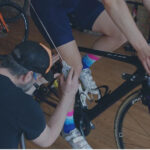Learning to ride a bike with no handlebars is a thrilling skill that enhances your cycling confidence and control. It might seem daunting at first, but with the right approach and consistent practice, you’ll be cruising hands-free in no time. This guide breaks down the process into manageable steps, ensuring you learn safely and effectively.
Getting Started: Preparation is Key
Before attempting to ride without handlebars, setting the stage for success is crucial. This involves choosing the right environment and ensuring your bike is in optimal condition.
Find the Right Environment
Just like a learner driver needs a quiet car park, you need a safe, open space to practice. A smooth, flat surface like an empty parking lot or a quiet, traffic-free road is ideal. Avoid practicing on soft surfaces like grass initially, as they can make steering and balance more challenging in the beginning. You want consistent feedback from the ground as you learn to control your bike through balance.
Bike Check
Ensure your bicycle is in good working order. Check your tire pressure, brakes, and make sure your seat is at a comfortable height. A well-maintained bike will respond predictably, boosting your confidence as you learn this new skill.
The Secret: Steering with Your Weight
The core of riding a bike with no handlebars lies in mastering weight-based steering. You likely already use this technique subconsciously, but now it’s time to bring it to the forefront.
Practice Weight Shifting
Before taking your hands off the handlebars, practice intentionally steering by shifting your weight. While riding with both hands on the bars, gently sway your body from side to side. Notice how even subtle shifts in your weight influence the bike’s direction. Focus on initiating turns by leaning slightly rather than forcefully turning the handlebars. This practice will build the essential muscle memory for no-hands riding.
Taking Your Hands Off: Step-by-Step
Now for the exciting part – gradually transitioning to riding without handlebars. This is an all-in exercise; attempting one-handed riding isn’t a necessary intermediate step.
Start with Light Hands
Begin by riding in a straight line on your chosen practice surface. Place your hands lightly on top of the handlebars, relaxing your grip. If you have drop handlebars, rest your hands gently on the tops. The key here is to be ready to quickly regain control if needed, but to consciously reduce your reliance on your hands for balance.
Gradual Release
With your hands lightly placed, slowly lift them just a fraction of an inch off the bars. Don’t look down at your hands; keep your focus forward. That small lift will feel significant initially. Maintain your balance by steering with your weight, just as you practiced.
Practice Balance
As you become more comfortable with brief moments of hands-free riding, gradually increase the duration. Focus on making small adjustments with your core and weight to stay balanced and maintain a straight line. You’ll notice that even minor shifts in your center of gravity have a considerable impact on your stability. The more you practice, the more natural and less precarious this will feel.
Mastering Turns
Once you’re confident riding straight, it’s time to tackle corners. Continue using weight steering to initiate turns. Lean gently in the direction you want to go, and your bike will follow. Start with wide, gentle turns and gradually progress to tighter ones as your balance improves.
Safety First: Remember How to Stop
While riding without handlebars is exhilarating, always remember safety. Be aware that your primary method of sudden braking is compromised. Unless you have specialized equipment, stopping quickly might become challenging and potentially uncomfortable without hands readily available for brakes. Practice in safe environments and avoid situations where sudden stops might be necessary.
Conclusion
Learning to ride a bike with no handlebars is a rewarding achievement that enhances your bike handling skills and overall cycling enjoyment. By practicing in a safe environment, mastering weight steering, and gradually progressing through these steps, you’ll soon experience the freedom of riding hands-free. Remember to be patient with yourself, practice consistently, and always prioritize safety. Enjoy the ride!

